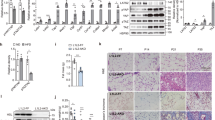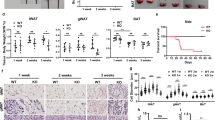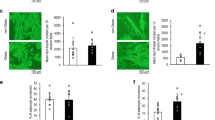Abstract
Background
The role of adipose tissue in the pathophysiology of cardiovascular disease remains a major subject of research. The objective of the present study was to dissect the molecular mechanisms that regulate the survival and differentiation of cardiac cells in an obese environment.
Material and methods
We isolated murine/human cardiac cells from adult hearts of control and obese mice/subjects and analyzed the communication between cardiac cells and adipocytes in vitro, as well as the effects on their main functions such as survival and differentiation.
Results
We found that the presence of visceral or subcutaneous adipocytes in the environment of cardiomyocytes or cardiac precursors provoked apoptosis or blocked differentiation, respectively, and these effects were mediated by secreted adipokines. Remarkably, cardiac precursors changed their fate and differentiated into mature adipocytes, contributing to the overall increase in adipose cell content. Inhibiting the adipokines TNF-α, visfatin, or HMGB1 could block the deleterious effects of adipokines on cardiac cells.
Conclusions
Our findings demonstrate that mouse and human visceral adipose tissue contributes negatively to the homeostasis and regeneration of the heart. Moreover, our results suggest that blocking the action of certain adipokines might enhance cardiac differentiation and survival.
This is a preview of subscription content, access via your institution
Access options
Subscribe to this journal
Receive 12 print issues and online access
$259.00 per year
only $21.58 per issue
Buy this article
- Purchase on Springer Link
- Instant access to full article PDF
Prices may be subject to local taxes which are calculated during checkout






Similar content being viewed by others
References
San Martin N, Galvez BG. A new paradigm for the understanding of obesity: the role of stem cells. Arch Physiol Biochem. 2011;117:188–94.
Monteiro R, Azevedo I. Chronic inflammation in obesity and the metabolic syndrome. Mediators Inflamm. 2010;2010: pii: 289645.
Coelho M, Oliveira T, Fernandes R. Biochemistry of adipose tissue: an endocrine organ. Arch Med Sci. 2013;9:191–200.
Kopelman PG. Obesity as a medical problem. Nature. 2000;404:635–43.
Lau DC, Schillabeer G, Li ZH, Wong KL, Varzaneh FE, Tough SC. Paracrine interactions in adipose tissue development and growth. Int J Obes Relat Metab Disorder. 1996;20(Suppl 3):S16–25.
Mohamed-Ali V, Pinkney JH, Coppack SW. Adipose tissue as an endocrine and paracrine organ. Int J Obes Relat Metab Disorders. 1998;22:1145–58.
Despres JP. Health consequences of visceral obesity. Ann Med. 2001;33:534–41.
Lavie CJ, Milani RV, Ventura HO. Obesity and cardiovascular disease: risk factor, paradox, and impact of weight loss. J Am Coll Cardiol. 2009;53:1925–32.
Kahn SE, Hull RL, Utzschneider KM. Mechanisms linking obesity to insulin resistance and type 2 diabetes. Nature. 2006;444:840–6.
Jung UJ, Choi MS. Obesity and its metabolic complications: the role of adipokines and the relationship between obesity, inflammation, insulin resistance, dyslipidemia and nonalcoholic fatty liver disease. Int J Mol Sci. 2014;15:6184–223.
Berry DC, Stenesen D, Zeve D, Graff JM. The developmental origins of adipose tissue. Development. 2013;140:3939–49.
Rodeheffer MS, Birsoy K, Firedman JM. Identification of white adipocyte progenitor cells in vivo. Cell. 2008;135:240–9.
Zeve D, TAng W,JG. Fighting fat with fat: the expanding field of adipose stem cells. Cell Stem Cell. 2009;5:472–81.
Majka SM, Barak Y, Adipocyte DJK. Origins: Weighing the possibilities. Stem Cells. 2011;29:1034–40.
Balistreri CR, Caruso C, Candore G. The role of adipose tissue and adipokines in obesity-related inflammatory diseases. Med Inflamm. 2010;2010:802078.
Wang Z, Nakayama T. Inflammation, a link between obesity and cardiovascular disease. Med Inflamm. 2010;2010:535918.
Hubert HB, Feinleib M, McNamara PM, Castelli WP. Obesity as an independent risk factor for cardiovascular disease: a 26-year follow-up of participants in the Framingham Heart Study. Circulation. 1983;67:968–77.
Eckel RH. Obesity and heart disease: a statement for healthcare professionals from the Nutrition Committee, American Heart Association. Circulation. 1997;96:3248–50.
Rimm EB, Stampfer MJ, Giovannucci E, Ascherio A, Spiegelman D, Colditz GA, et al. Body size and fat distribution as predictors of coronary heart disease among middle-aged and older US men. Am J Epidemiol. 1995;141:1117–27.
Willett WC, Manson JE, Stampfer MJ, Colditz GA, Rosner B, Speizer FE, et al. Weight, weight change, and coronary heart disease in women. Risk within the ‘normal’ weight range. JAMA. 1995;273:461–5.
Clement K, Vaisse C, Lahlou N, Cabrol S, Pelloux V, Cassuto D, et al. A mutation in the human leptin receptor gene causes obesity and pituitary dysfunction. Nature. 1998;392:398–401.
Galli D, Innocenzi A, Staszewsky L, Zanetta L, Sampaolesi M, Bai A, et al. Mesoangioblasts, vessel-associated multipotent stem cells, repair the infarcted heart by multiple cellular mechanisms: a comparison with bone marrow progenitors, fibroblasts, and endothelial cells. Arterioscler Thromb Vasc Biol. 2005;25:692–7.
Galvez BG, San Martin N, Rodriguez C. TNF-alpha is required for the attraction of mesenchymal precursors to white adipose tissue in Ob/Ob mice. PloS ONE. 2009;4:e4444.
Bernal A, Fernandez M, Perez LM, San Martin N, Galvez BG. Method for obtaining committed adult mesenchymal precursors from skin and lung tissue. PloS ONE. 2012;7:e53215.
Perez LM, Bernal A, San Martin N, Lorenzo M, Fernandez-Veledo S, Galvez BG. Metabolic rescue of obese adipose-derived stem cells by Lin28/Let7 pathway. Diabetes. 2013;62:2368–79.
Galvez BG, Sampaolesi M, Barbuti A, Crespi A, Covarello D, Brunelli S, et al. Cardiac mesoangioblasts are committed, self-renewable progenitors, associated with small vessels of juvenile mouse ventricle. Cell Death Differ. 2008;15:1417–28.
Galvez BG, Covarello D, Tolorenzi R, Brunelli S, Dellavalle A, Crippa S, et al. Human cardiac mesoangioblasts isolated from hypertrophic cardiomyopathies are greatly reduced in proliferation and differentiation potency. Cardiovas Res. 2009;83:707–16.
Shynkar VV, Klymchenko AS, Kunzelmann C, Duportail G, Muller CD, Demchenko AP, et al. Fluorescent biomembrane probe for ratiometric detection of apoptosis. J Am Chem Soc. 2007;129:2187–93.
Vidal H. Gene expression in visceral and subcutaneous adipose tissues. Ann Med. 2001;33:547–55.
Lin F, Zhang W, Xue D, Zhu T, Li J, Chen E, et al. Signaling pathways involved in the effects of HMGB1 on mesenchymal stem cell migration and osteoblastic differentiation. Int J Mol Med. 2016;37:789–97.
Palumbo R, Sampaolesi M, De Marchis F, Tonlorenzi R, Colombetti S, Mondino A, et al. Extracellular HMGB1, a signal of tissue damage, induces mesoangioblast migration and proliferation. J Cell Biol. 2004;164:441–9.
Mathew B, Francis L, Kayalar A, Cone J. Obesity: effects on cardiovascular disease and its diagnosis. J Am Board Fam Med. 2008;21:562–8.
Nakamura K, Fuster JJ, Walsh K. Adipokines: a link between obesity and cardiovascular disease. J Cardiol. 2014;63:250–9.
Burke GL, Bertoni AG, Shea S, Tracy R, Watson KE, Blumenthal RS, et al. The impact of obesity on cardiovascular disease risk factors and subclinical vascular disease: the Multi-Ethnic Study of Atherosclerosis. Archiv Intern Med. 2008;168:928–35.
Luaces M, Cachofeiro V, Garcia-Munoz-Najar A, Medina M, Gonzalez N, Cancer E, et al. Anatomical and functional alterations of the heart in morbid obesity. Changes after bariatric surgery. Rev Esp Cardiol. 2012;65:14–21.
Halvorsen YD, Wilkison WO, Briggs MR. Human adipocyte proteomics—a complementary way of looking at fat. Pharmacogenomics. 2000;1:179–85.
Wang P, Mariman E, Renes J, Keijer J. The secretory function of adipocytes in the physiology of white adipose tissue. J Cell Physiol. 2008;216:3–13.
Patel VB, Shah S, Verma S, Oudit GY. Epicardial adipose tissue as a metabolic transducer: role in heart failure and coronary artery disease. Heart Fail Rev. 2017;22:889–902.
Yudkin JS, Eringa E, Stehouwer CD. “Vasocrine” signalling from perivascular fat: a mechanism linking insulin resistance to vascular disease. Lancet. 2005;365:1817–20.
Xu FP, Chen MS, Wang YZ, Yi Q, Lin SB, Chen AF, et al. Leptin induces hypertrophy via endothelin-1-reactive oxygen species pathway in cultured neonatal rat cardiomyocytes. Circulation. 2004;110:1269–75.
Chen ZW, Qian JY, Ma JY, Chang SF, Yun H, Jin H, et al. TNF-alpha-induced cardiomyocyte apoptosis contributes to cardiac dysfunction after coronary microembolization in mini-pigs. J Cell Mol Med. 2014;18:1953–63.
Mazurek T, Zhang L, Zalewski A, Mannion JD, Diehl JT, Arafat H, et al. Human epicardial adipose tissue is a source of inflammatory mediators. Circulation. 2003;108:2460–6.
Yang R, Chang L, Wang M, Zhang H, Liu J, Wang Y, et al. MAPK pathway mediates the induction of visfatin in neonatal SD rat cardiomyocytes pretreated with glucose. Biomed Rep. 2014;2:282–6.
Galvez BG, Sampaolesi M, Brunelli S, Covarello D, Gavina M, Rossi B, et al. Complete repair of dystrophic skeletal muscle by mesoangioblasts with enhanced migration ability. J Cell Biol. 2006;174:231–43.
Gunasekaran MK, Viranaicken W, Girard AC, Festy F, Cesari M, Roche R, et al. Inflammation triggers high mobility group box 1 (HMGB1) secretion in adipose tissue, a potential link to obesity. Cytokine. 2013;64:103–11.
Cavalera M, Wang J, Frangogiannis NG. Obesity, metabolic dysfunction, and cardiac fibrosis: pathophysiological pathways, molecular mechanisms, and therapeutic opportunities. Transl Res. 2014;164:323–35.
Fernández-Vedelo S, Nieto-Vazquez I, De Castro J, Ramos MP, Brüderlein S, Möler P, et al. Hyperinsulinemia induces insulin resistance on glucose and lipid metabolism in a human adipocytic cell line: Paracrine interaction with myocytes. J Clin Endocrinol Metab. 2008;93:2866–76.
Lughetti L, China M, Berri R, Predieri B. Pharmacological treatment of obesity in children and adolescents: present and future. J Obes. 2011;2011:928165.
Raab H, Weiner RA, Frenken M, Rett K, Weiner S. Obesity and metabolic surgery in type 1 diabetes mellitus. Nutr Hosp. 2013;28(Suppl 2):31–4.
Acknowledgements
This study was supported by funding from the Spanish Ministry of Science and Innovation (SAF2015-67911-R) to BGG. BdL is supported by an FPU fellowship from the Spanish Ministry of Science and Innovation. We would like to thank Dr Kenneth McCreath for critically reviewing the paper.
Author information
Authors and Affiliations
Contributions
LMP, BdL, and AB carried out the experiments. All authors contributed to drafting and reviewing the paper. LMP and BGG wrote the paper and discussed data.
Corresponding author
Ethics declarations
Conflict of interest
The authors declare that they have no conflict of interest.
Additional information
Publisher’s note Springer Nature remains neutral with regard to jurisdictional claims in published maps and institutional affiliations.
Supplementary information
Rights and permissions
About this article
Cite this article
Pérez, L.M., de Lucas, B., Bernal, A. et al. Adipokines disrupt cardiac differentiation and cardiomyocyte survival. Int J Obes 44, 908–919 (2020). https://doi.org/10.1038/s41366-019-0455-4
Received:
Revised:
Accepted:
Published:
Issue Date:
DOI: https://doi.org/10.1038/s41366-019-0455-4
This article is cited by
-
Cardiac-to-adipose axis in metabolic homeostasis and diseases: special instructions from the heart
Cell & Bioscience (2023)



